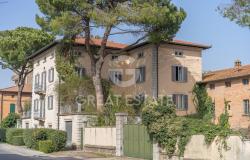
Taxi drivers up in arms over plans to deregulate their sector converged on Rome on Monday ahead of key talks with the government. More than 2,000 drivers assembled at the famed Roman chariot-racing grounds of Circus Maximus. They parked their cars and then proceeded to march into the centre where union representatives were due to resume talks with the government at 16.00 local time.
The route used by the drivers was closed to traffic and lined with police.
One group of protesters staged a mock crucifixion, carrying a fellow demonstrator through the streets chained to a fake wooden cross.
At the feet of the 'crucified' driver was a plaque which said "give us back our daily bread, Amen". Meanwhile, taxi drivers across the country continued a wildcat strike for the fourth day running. In Rome, taxi ranks were deserted at the airport and main train station while in Milan, Turin and Bologna, drivers were only responding to emergency calls from the sick and elderly.
The protest turned violent at Circus Maximus with drivers assaulting a journalist working for Corriere della Sera, Italy's biggest daily. It was the second attack on a journalist since drivers renewed their protests over the deregulation plans last Friday.
Rome Mayor Walter Veltroni condemned the attack, saying it was "unacceptable".
Civil Service Minister Luigi Nicolais told the drivers that the government was open to suggestions for improving the decree but had no intention of withdrawing it. "The drivers will have to get used to the idea (of deregulation) because the government is not going to do a U-turn," he said.
The new, centre-left government unveiled its deregulation bill in a surprise move at the end of June, sparking six days of wildcat protests by the drivers. The original decree would have liberalised taxi licensing and broken the virtual monopoly status of local taxi federations.
It allowed municipal administrations to increase the number of taxi licences issued and give out temporary permits during predictably busy periods.
One of the most controversial aspects was a measure which would have allowed private firms to enter the sector by acquiring licences and then hiring their own drivers. Unions said this would allow major companies like Fiat to take over the sector and then hire drivers at their own rates, forcing independent drivers out of the market.
They also expressed concern that the reform would destroy the value of their taxi licences.
Taxi licences are regarded as private property by their holders, who trade them on when they retire or pass them on to their children. The practice has created a grey market in which the cost of a permit can reach as high as 200,000 euros.
The protests were called off after the government agreed to hold talks with taxi unions but resumed again last Friday. The government insists it only wants to improve taxi services in Italian cities and ensure there are enough taxis to meet demand.
It has agreed to modify the bill, proposing that a single licence be used to cover two vehicles, initially on an experimental basis.
The unions have rejected the proposal, suggesting instead that two drivers be able to operate under a single licence, meaning in effect that each taxi vehicle would then be working non-stop.
Italy's 40,000-strong fleet of taxis is the smallest in Europe. According to official statistics, there are 2.1 taxis per thousand inhabitants in Rome compared to 8.3 in London and 9.9 in Barcellona. The number of taxis operating in Rome is 5,820, compared to more than 61,000 in London, almost 43,000 in New York and 17,000 in Paris.
Complaints from residents and tourists over the difficulty in finding taxis during peak hours and at night have shot up in recent years, with taxi drivers accused of deliberately restricting the number of cars available in order to safeguard their earnings and the values of their licences.











